Hampton Bay Pilot Project
Learn more about this pilot project with Hampton Bay HOA in Benicia that is yielding water savings for the HOA and will serve as a model for future waterwise native landscaping following permaculture principles and healthy soil biology that moves away from water-hungry lawns. This page highlights different sections of the pilot site and offers some details about the size, rainwater capture and irrigation savings.
Pilot Project Highlights
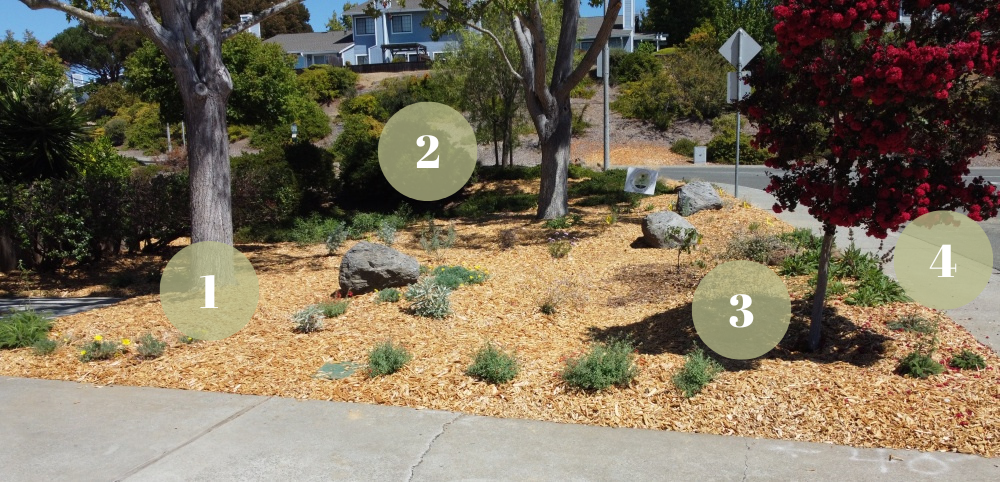
Section 1: Rainwater Catchment Basins
This native garden is able to catch and utilize approximately 663 gallons of rainwater per 1 inch of rain captured from the nearby rooftops and directed into basins. These basins are small or large indentations in the landscape where water can sit while slowly infiltrating the soil. This process recharges the surrounding groundwater and can completely eliminate the need for supplemental irrigation once the native plants have been established. These types of basins are an effective way to reduce the need for irrigation, mitigate flooding from stormwater surges, filter and clean water through the soil before it enters our waterways, and hydrate the landscapes within our watersheds.
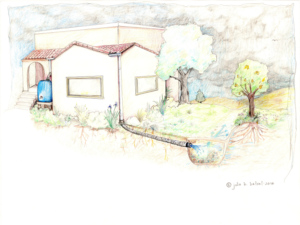
Section 3: Plant Guilds
A lot of consideration went into the types of plants used in this garden. Aside from selecting plants for native wildlife, water needs, and aesthetics, the relationships between plants was also considered. This is a type of planting strategy where different plants’ needs and characteristics are considered in relation to each other.
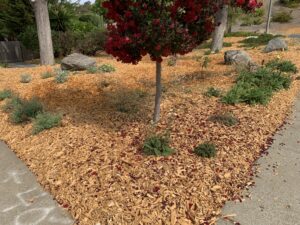
In the example in the picture above there was an existing tree (crepe myrtle). Trees need nitrogen and other forms of nutrients to thrive.

Achillea millefolium – Common Yarrow
The nearby native silver lupine and yarrow both have flowers in spring that support native wildlife, but helps support the tree and each other. The lupine forms a relationship with a type of bacteria that takes nitrogen out of the atmosphere and puts it into the soil in a form that can become available to surrounding plants. Deep-rooted plants and plants that are considered nutrient accumulators, such as the yarrow, are effective in drawing nutrients deep from the soil and bringing them up into higher layers so that they can become available to other plants, such as the lupine. Nutrients in the soil are sourced and cycled through many different plants, insects, and the microbial life in the soil, creating a holistic and resilient approach to the health and well-being of the entire garden.
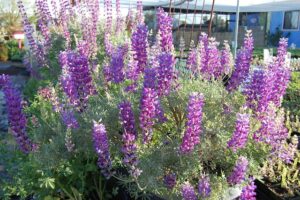
Lupinus albifrons – Silver Lupine
Section 3: Plant Guilds
A lot of consideration went into the types of plants used in this garden. Aside from selecting plants for native wildlife, water needs, and aesthetics, the relationships between plants was also considered. This is a type of planting strategy where different plants’ needs and characteristics are considered in relation to each other.

In the example in the picture above there was an existing tree (crepe myrtle). Trees need nitrogen and other forms of nutrients to thrive.
The nearby native silver lupine and yarrow both have flowers in spring that support native wildlife, but helps support the tree and each other. The lupine forms a relationship with a type of bacteria that takes nitrogen out of the atmosphere and puts it into the soil in a form that can become available to surrounding plants. Deep-rooted plants and plants that are considered nutrient accumulators, such as the yarrow, are effective in drawing nutrients deep from the soil and bringing them up into higher layers so that they can become available to other plants, such as the lupine. Nutrients in the soil are sourced and cycled through many different plants, insects, and the microbial life in the soil, creating a holistic and resilient approach to the health and well-being of the entire garden.

Achillea millefolium – Common Yarrow

Lupinus albifrons – Silver Lupine
Section 2: Milkweed, Monarchs & Native Connections
This area is densely planted with narrowleaf milkweed (Asclepias fascicularis), which is native to this region. Milkweed is the only plant that the Monarch butterfly lays its eggs on, and that the Monarch caterpillar eats. A diet that is exclusive to milkweed ensures that the caterpillar and butterfly remain toxic to would-be predators. Planting milkweed can help the survival of the Monarch butterfly as well as ensuring that Monarch butterflies grace these gardens with their beauty as they fly in to lay their eggs.
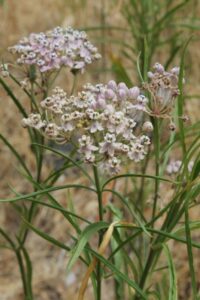
Asclepias fascicularis – Narrowleaf Milkweed
The relationship between milkweed and Monarch butterflies highlights many of the connections that are found in nature that make it important to consider natives first in our gardens. Many animals and insects rely on the timing of pollen and nectar production from native plants for their survival. By dedicating at least a percentage of our gardens to pollinators, we can provide points along their migratory journeys that not only help ensure their survival but enliven our gardens with a diverse population of insects and birds that remind us of our place in nature and replace the sterility of our lawn-dominant landscapes.
Additional native flowers in this garden that draw in native wildlife include Golden Poppies (yellow), White Yarrow (white), California fuschia (red), Silver Lupine (purple), Nude Buckwheat (yellow), and California Bee Plant. View all of these flowers and other plants in the garden here.
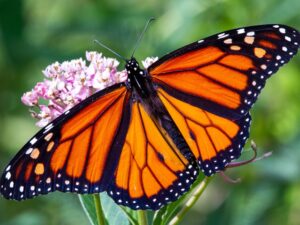
Section 2: Milkweed, Monarchs & Native Connections
This area is densely planted with narrowleaf milkweed (Asclepias fascicularis), which is native to this region. Milkweed is the only plant that the Monarch butterfly lays its eggs on, and that the Monarch caterpillar eats. A diet that is exclusive to milkweed ensures that the caterpillar and butterfly remain toxic to would-be predators. Planting milkweed can help the survival of the Monarch butterfly as well as ensuring that Monarch butterflies grace these gardens with their beauty as they fly in to lay their eggs.

Asclepias fascicularis – Narrowleaf Milkweed
The relationship between milkweed and Monarch butterflies highlights many of the connections that are found in nature that make it important to consider natives first in our gardens. Many animals and insects rely on the timing of pollen and nectar production from native plants for their survival. By dedicating at least a percentage of our gardens to pollinators, we can provide points along their migratory journeys that not only help ensure their survival but enliven our gardens with a diverse population of insects and birds that remind us of our place in nature and replace the sterility of our lawn-dominant landscapes.
Additional native flowers in this garden that draw in native wildlife include Golden Poppies (yellow), White Yarrow (white), California fuschia (red), Silver Lupine (purple), Nude Buckwheat (yellow), and California Bee Plant. View all of these flowers and other plants in the garden here.

Section 4: A Sensory Experience
This garden doesn’t exist out in a meadow somewhere out of sight. This garden is within an active community and in front of a resident’s home. Therefore, the experience of the garden cannot be limited to just the wildlife, but must include the human experience. For that reason, native plants with varying colors were layered in ways that will draw visitors’ eyes to certain features within the landscape and are visually interesting.
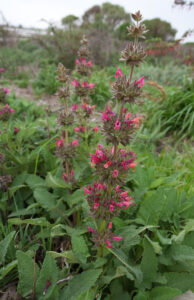
Salvia spathacea – Hummingbird Sage
Flowers such as hummingbird sage that will draw in hummingbirds and produce a beautiful, strong fragrance when in bloom that is calming and grounding. For this reason, hummingbird sage was planted along the pathways where its smell can be enjoyed by visitors. The garden involves all of the senses for human enjoyment, serenity and relaxation, which helps to make these landscapes more appealing as communities transition from water-hungry lawns to regenerative and sustainable landscapes that reunite humans with the natural world.
Section 4: A Sensory Experience
This garden doesn’t exist out in a meadow somewhere out of sight. This garden is within an active community and in front of a resident’s home. Therefore, the experience of the garden cannot be limited to just the wildlife, but must include the human experience. For that reason, native plants with varying colors were layered in ways that will draw visitors’ eyes to certain features within the landscape and are visually interesting.

Salvia spathacea – Hummingbird Sage
Flowers such as hummingbird sage that will draw in hummingbirds and produce a beautiful, strong fragrance when in bloom that is calming and grounding. For this reason, hummingbird sage was planted along the pathways where its smell can be enjoyed by visitors. The garden involves all of the senses for human enjoyment, serenity and relaxation, which helps to make these landscapes more appealing as communities transition from water-hungry lawns to regenerative and sustainable landscapes that reunite humans with the natural world.
Site Details
Installation:
Spring-Summer 2022
Design by Michael Wedgley; installation by Jerry Saitta of Saitta’s Gardening & Landscape
Size:
1,073 square feet
Sun Exposure:
6-8 hours
Soil:
Clay
Number of Swales:
4
Secondary Water:
Rainwater
Roof water diverted to swales
Total annual water impact:
Estimated 13,000 to 14,000 gallons of rainwater harvested from the roof annually.
The HOA estimates a 70% to 90% water savings moving this site from lawn watered with a sprinkler system to a native plant design with drip irrigation for the first few years. After three years, the plants should be established enough to turn off the drip irrigation, resulting in even larger water savings.

